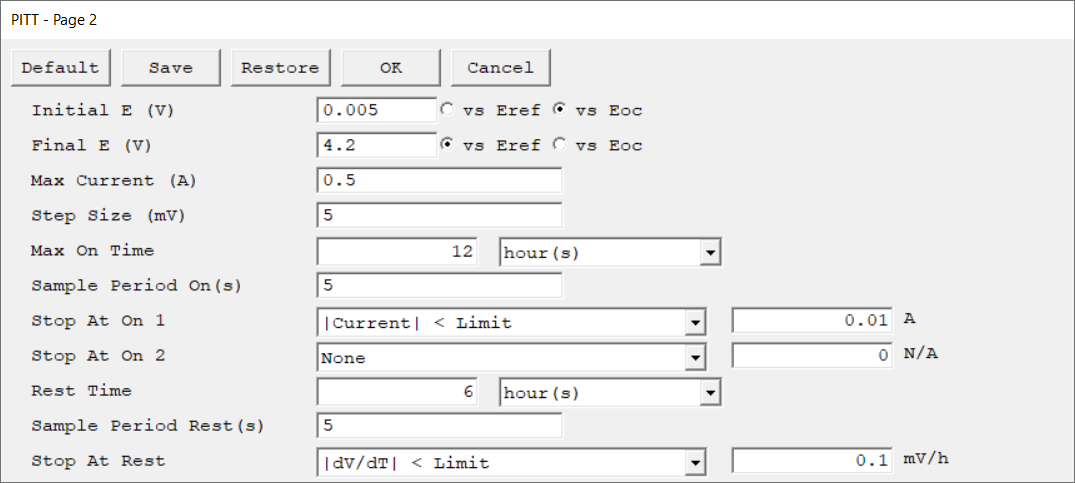Description
Second setup page of the Potentiostatic Intermittent Titration Technique experiment. Press OK to continue or Cancel to go back to the first setup page.
Parameter |
Description |
Units |
|||||||||||||||||||||||||||||||||||
|---|---|---|---|---|---|---|---|---|---|---|---|---|---|---|---|---|---|---|---|---|---|---|---|---|---|---|---|---|---|---|---|---|---|---|---|---|---|
The voltage at which the first pulse is applied. Typically, this value is 5-20 mV vs. Eoc for a charge step and 4.20 V vs. Eref for a discharge step. |
volts (V) |
||||||||||||||||||||||||||||||||||||
The voltage at which the final pulse is applied. Typically, this value is 4.2 V vs. Eref for a charge step and 3.0 V vs. Eref for a discharge step. |
volts (V) |
||||||||||||||||||||||||||||||||||||
Max Current controls the current measurement range if I/E Range is set to Fixed mode. If I/E Range is set to Auto mode, Max Current specifies the maximum expected starting current.
To avoid overloading the instrument (so you can accurately track the total charge passed), set Max Current to a value below the instrument's maximum current capabilities.
|
amperes (A) |
||||||||||||||||||||||||||||||||||||
The voltage step increments of the pulse signals. This is always entered as a positive number, even for a discharge step. |
mV |
||||||||||||||||||||||||||||||||||||
Duration of each voltage pulse to be applied. |
seconds (s), minutes (min), hours (hr), days (d) |
||||||||||||||||||||||||||||||||||||
The spacing between data points during the pulse signals. |
seconds (s) |
||||||||||||||||||||||||||||||||||||
Specify various limits to an experiment. Choose a limit criterion from the drop-down list and enter a limit value. The unit automatically updates according to the criterion. The limit, if met, causes the experiment to skip to the next step, or stop if there is no subsequent step.
Most experiments have Stop At On 1 and Stop At On 2 criteria. These parameters are treated equally, and if both are used, they are both tested on every raw data point. If either limit is reached, the experiment skips to the next step or stops entirely.
|
|
||||||||||||||||||||||||||||||||||||
|
|||||||||||||||||||||||||||||||||||||
The duration of each rest phase during the experiment. A typical value is 10–15 minutes. |
seconds (s), minutes (min), hours (hr), days (d) |
||||||||||||||||||||||||||||||||||||
The spacing between data points during the rest periods. |
seconds (s) |
||||||||||||||||||||||||||||||||||||
Specify various limits during the rest periods. The limit, if met, causes the experiment to skip to the next step, or stop if there is no subsequent step. See the Stop At On parameters for more details about the limits. |
|

